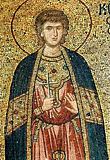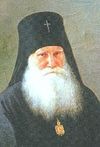

| Previous day | Next day |
| Old Style
October 12
|
Monday |
New Style
October 25
|
| 19th Week after Pentecost. Tone 1. | No fast.
|
![]() Martyrs Probus, Tarachus, and Andronicus, at Tarsus in Cilicia (304).
Martyrs Probus, Tarachus, and Andronicus, at Tarsus in Cilicia (304). ![]() St. Cosmas the Hymnographer, bishop of Maiuma (ca. 787).
St. Cosmas the Hymnographer, bishop of Maiuma (ca. 787).
Martyr Domnina of Anazarbus (286). St. Martin the Merciful, bishop of Tours (397). Sts. Amphilochius (1452), Macarius (1480), and Tarasius (1440), abbots, and Theodosius, monk (15th c.), of Glushitsa Monastery (Vologda), disciples of St. Dionysius of Glushitsa. Uncovering of the relics of St. Macarius of Zheltovodsk and Unzha (1671). Translation from Malta to Gatchina: of a Particle of the Life Giving Cross, the Filersk Icon of the Mother of God, and the relic of the Right Hand of John the Baptist (1799). St. Arsenius, archimandrite, of Svyatogorsk Monastery (1859). St. Euphrosyne (Mezenova) the Faster, schema-abbess, of Siberia (1918). Glorification of St. Philaret, archbishop of Chernigov (2009).
New Hieromartyr Lawrence (Levchenko), hieromonk, of Optina Monastery (1937). New Hiero-confessor Nicholas (Mogilevsky), metropolitan of Alma-Ata (1955).
“Jerusalem” (48) and “Kaluga” (1748) Icons of the Most Holy Theotokos.
Hieromartyr Maximilian, bishop of Noricum (284). St. Mobhi of Glasnevin (Ireland) (544). Martyr Edwin, king of Northumbria (633). St. Wilfrid, bishop of York (709). Translation of the relics of St. Sabbas the Sanctified from Rome to Jerusalem (1965). Virgin-martyr Anastasia of Rome (ca. 250). St. Theodotus, bishop of Ephesus. St. Jason, bishop of Damascus. St. Symeon the New Theologian [transferred from Great Lent, March 12] (1022). St. Theosebius the God-bearer, of Arsinoe on Cyprus.
Thoughts for Each Day of the Year
According to the Daily Church Readings from the Word of God
By St. Theophan the Recluse

Monday. [Phil. 4:10-23; Luke 7:36-50]
How could it be that although Simon the Pharisee reveres the Lord and invites Him over, he is scandalized when he sees that He shows favour toward a sinful woman and permits her to approach Him? Why does he think to himself, “If He were a prophet,” and so forth? Because he had busied himself with the entertaining, and therefore ignored a sensible understanding of how God does things. These two realms, worldly and spiritual, are completely completely different characteristics and laws. Our mind all the while judges its own preoccupations according to the laws of those preoccupations. According to worldly thinking, one must not have contact with an obviously sinful woman. Simon judges thus, forgetting that repentance makes everyone pure and puts sinners on one level with the righteous. He thinks that the sinful woman should not be there, and that if the Saviour does not chase her away, it is probably because He does not know who she is. Another thought immediately follows this one: If He does not know that she is sinful, then what kind of prophet is He? He did not say this in words, but only thought it, although there was no change in his appearance outwardly. But the Lord saw his heart and corrected him accordingly. He suggested to him that sinners also have a place beside Him, and that the sinful woman who united with Him in her heart, revered Him more than did Simon, who honoured Him with nothing but food. Externals lead a person to a feeling of self-righteousness unpleasant to the Lord, while inner things always preserve a feeling of unworthiness before the face of the omniscient Lord.
Articles
 Martyrs Probus, Tarachus, and Andronicus, at Tarsus in CiliciaThe Martyrs Tarachus, Probus, and Andronicus suffered for Christ in the year 304 at Tarsus in Cilicia. |
 Martyr Domnina of AnazarbusThe Martyr Domnina of Anazarbus lived in the region of Cilicia, and suffered for confessing Christianity. |
 Venerable Amphilochius the Abbot of GlushetsaSaint Amphilochius, Abbot of Glushetsa, already a monk of priestly rank, came from Ustiug to Saint Dionysius of Glushetsa (July 1) in the year 1417. |
 “Jerusalem” Icon of the Mother of GodThe Jerusalem Icon of the Mother of God, by tradition, was painted by the holy Evangelist Luke fifteen years after the Ascension of the Lord at Gethsemane. |










